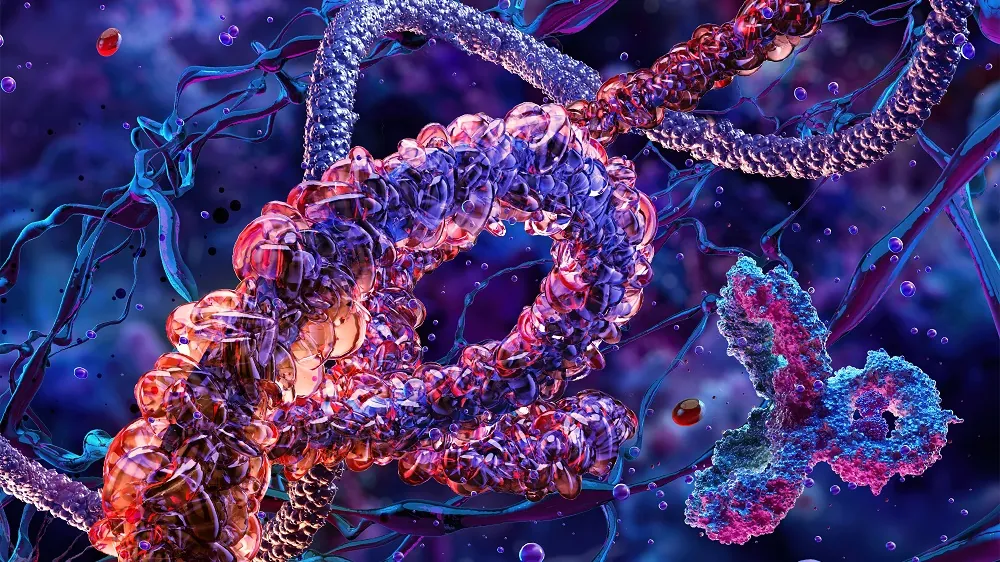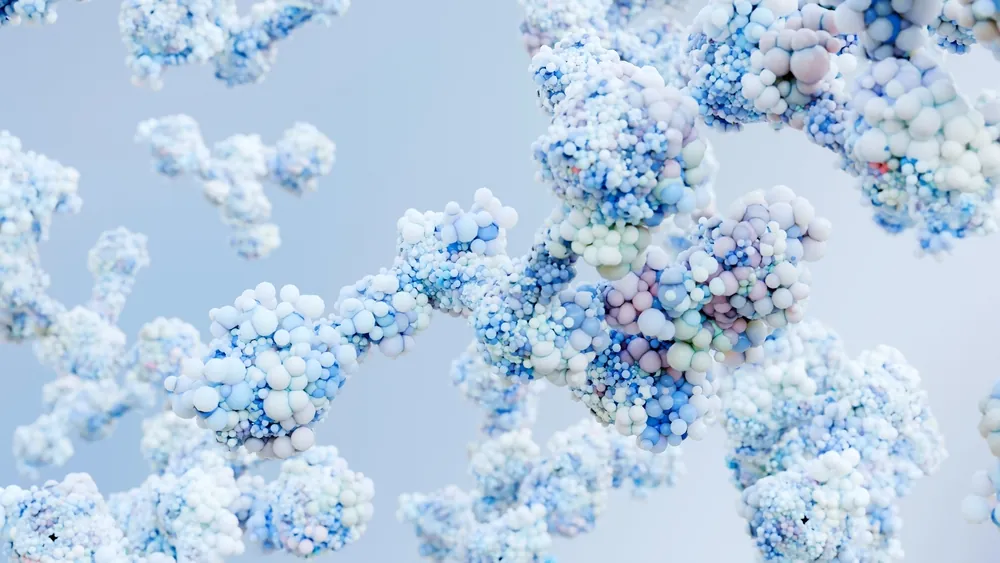In Aging Cell, researchers have explored how transcription factor EB (TFEB) promotes proteostasis in a common aging model.
Maintaining protein function
Proteostasis is naturally maintained by a quality control system that utilizes a network of chaperones and co-chaperones in order to handle all aspects of protein maintenance, including both folding and unfolding along with destruction of misfolded or otherwise damaged proteins [1]. This process is partially controlled by stress responses that act on transcription factors, which upregulate and downregulate proteostasis-related genes [2].
One of these key factors is coenzyme A (CoA), which is widely used throughout the body in multiple fundamental biochemical reactions, including mitochondrial energy-gathering processes, natural steroid synthesis, and protein management. To synthesize CoA, the body uses pantothenate kinase (PanK), which is the key bottleneck in its production [3]. As expected, genetic mutations that cause PanK deficiencies lead to severe diseases, such as brain degeneration [4].
CoA also produces clusters of iron and sulfur (ISCs) that are used as electron banks for biochemical reactions. While they are assembled in the mitochondria [5], they are transported throughout the cell through a complicated network, and disruptions to this network lead to serious diseases [6].
This work explores how CoA and ISCs are related to the common transcription factor TFEB. TFEB has an ortholog, HLH-30, in C. elegans worms, and so the researchers refer to it as HLH-30/TFEB throughout their paper.
A possible benefit of limitation
In C. elegans, full PanK depletion leads to similar problems as it does in humans [7]. However, halving its production does not lead to decreased lifespans in these worms.
Instead, worms that had a genetic mutation that led to PolyQ expansion, a proteostasis disorder that leads to formation of aggregates that cluster as foci within their bodies. Worms that had both this disorder and halved PanK production had fewer of these foci in their muscles, along with more activity and muscle movement, than worms that only had the disorder, although they had the same number of aggregates. Interestingly, this only occurred in worms treated with RNA interference (RNAi) to reduce PanK expression rather than worms that were created with halved PanK at the genetic level.
Intrigued, the researchers then turned to a model with a mutation that mis-encodes a crucial muscle protein, making it temperature sensitive. At the wrong temperature, worms with this mutation find it much more difficult to move as these proteins misfold. However, reducing PanK in these worms, through either a different genetic modification or RNAi, improves their movements at the wrong temperature, suggesting that proteostasis mechanisms are working harder.
Work with a labeled insulin protein recapitulated these findings. Worms that can properly process it place it, properly folded, into the body cavity, while worms that cannot process it leave the misfolded protein in the cells. Causing worms to undergo chronic stress through a mutation harms their proteostasis, meaning that they leave it in their cells; however, decreasing PanK through mutation or RNAi leads to more properly folded protein.
The resarchers then took a closer look at stress. They found that worms with less PanK were better at handling stress, whether that was due to a chemical insult or to heat shock; the difference was slight compared to unstressed controls, but it was still clearly visible in the data and statistically significant.
Finally, and critically, the same was found to be true of human cells. Bone cancer cells that were given a PanK inhibitor survived against heat shock more than cells not given the inhibitor. Similar results were found in another cell type. PanK inhibition did not affect these cells’ viability when there was no heat stress applied.
These results were found to be contingent on the resulting decreased levels of CoA. Worms that were given CoA in addition to decreased PanK had none of the previously observed benefits.
Protein chaperones to the rescue
Their findings led the researchers to investigate possible causes, looking closely at the mitochondria in an effort to find out why decreasing something as fundamental as CoA would lead to increased, not decreased, proteostasis. Most of the CoA-related pathways that they investigated were unfruitful; interfering with them only made things worse. However, silencing two genes relating to ISCs was found to be beneficial.
Further work found that interfering in these ISCs at any point was of benefit, whether it was their origination in the mitochondria or their transport throughout the cell. These effects were not additive with PanK silencing, demonstrating a chain of causality: the decrease in ISCs caused by PanK suppression leads to improvements in proteostasis.
These proteostasis improvements were not related to the proteasome nor the lysosome, which degrades misfolded proteins, nor did they have anything to do with the cellular clearing function known as autophagy. Instead, they were found to be related to an increase in chaperone-mediated protein folding; targeting these chaperones destroyed the ability of PanK reduction to increase performance under stress.
The role of TFEB
There were 13 specific chaperones found to improve heat shock survival, and 10 of them were related to HLH-30/TFEB in an existing data set. The mutants with less PanK had significant increases in a multitude of related genes. As with the CoA supplementation, interfering with HLH-30/TFEB stopped these chaperones from working and so prevented PanK reduction from increasing survival under heat shock conditions.
Therefore, the researchers concluded that reducing CoA and ISCs through decreased PanK is responsible for upregulating HLH-30/TFEB, which has substantial and beneficial downstream effects on protein folding through chaperones.
While very detailed in its biochemistry, this is a preliminary study. None of these treatments led to significant lifespan increases in worms, whether they were placed under stress or not. While they mentioned that it is a clear target, the researchers did not increase HLH-30/TFEB through a genetic intervention or other means. Further work, on worms and mice, will need to be done in order to determine if directly boosting chaperones could possibly be an effective treatment for proteostasis disorders such as Alzheimer’s and Parkinson’s.
Literature
[1] Jayaraj, G. G., Hipp, M. S., & Hartl, F. U. (2020). Functional modules of the proteostasis network. Cold Spring Harbor Perspectives in Biology, 12(1), a033951.
[2] Pessa, J. C., Joutsen, J., & Sistonen, L. (2024). Transcriptional reprogramming at the intersection of the heat shock response and proteostasis. Molecular cell, 84(1), 80-93.
[3] Robishaw, J. D., & Neely, J. R. (1985). Coenzyme A metabolism. American Journal of Physiology-Endocrinology And Metabolism, 248(1), E1-E9.
[4] Gregory, A., & Hayflick, S. J. (2017). Pantothenate kinase-associated neurodegeneration.
[5] Paul, V. D., & Lill, R. (2015). Biogenesis of cytosolic and nuclear iron–sulfur proteins and their role in genome stability. Biochimica Et Biophysica Acta (BBA)-Molecular Cell Research, 1853(6), 1528-1539.
[6] Maio, N., & Rouault, T. A. (2020). Outlining the complex pathway of mammalian Fe-S cluster biogenesis. Trends in Biochemical Sciences, 45(5), 411-426.
[7] Samuelson, A. V., Carr, C. E., & Ruvkun, G. (2007). Gene activities that mediate increased life span of C. elegans insulin-like signaling mutants. Genes & development, 21(22), 2976-2994.





